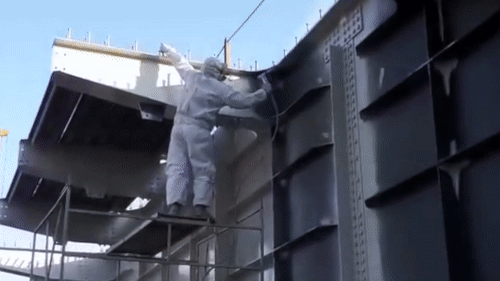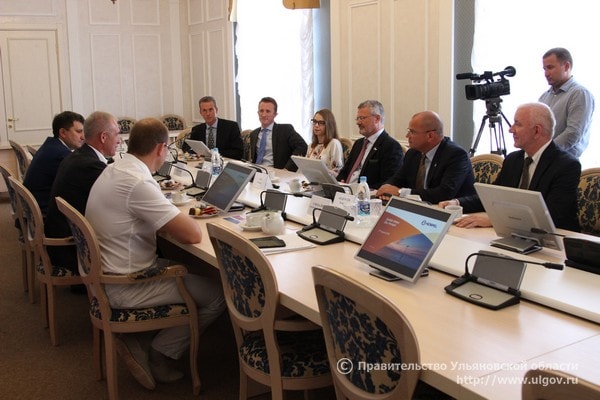

It allegedly came as a shock to the top management of the Danish paint-producing giant, Hempel, when it was discovered in 2019 that the controversial Crimean Bridge was painted with the company’s products.
According to the Danish management, they had been “deceived” by Russian employees who had sold products to the Russian bridge between 2016 and 2019, despite the fact that the bridge is subject to severe EU sanctions and condemned by the UN General Assembly. Hempel’s management denies having any knowledge of the sales when they were carried out.
Today, Danwatch can reveal that during the same period, there was extensive and publicly available evidence that Hempel’s products were used on a large scale on the bridge.
A large number of photos and videos, where Hempel’s characteristic blue and silver paint buckets are clearly visible, have been shared and discussed for years in Russian news media, on social media, on internet forums, and by Hempel’s own business partners in Russia – including the company SSK-Protekt LLC, from whom the video at the top of this article originates.
SSK-Protekt prides itself on being the official Hempel representative in the Arkhangelsk region and has previously stated to local media in Russia that it has painted 300,000 square meters of the Crimean Bridge.
The photos document that Hempel’s products have been used on the bridge as far back as the summer of 2017.
Nevertheless, Hempel maintains that no one in the management had any knowledge of wrongdoing and that the entire responsibility lies with a group of Russian employees who deceived Hempel by concealing the deliveries in the order books.
Danwatch has obtained a statement made to the Danish Business Authority, prepared by the law firm Kromann Reumert on behalf of Hempel A/S. The statement was submitted after the company discovered the deliveries in 2019.
The statement also states that deliveries to the bridge connecting Russia to Crimea, which has been subject to EU sanctions since 2014 as a result of Russia’s illegal annexation of the peninsula that year, had previously been discussed internally in Hempel.
“As part of the investigation, it has been established that the bridge was discussed internally in Hempel Russia and with Hempel A/S, but that it was concluded and clearly instructed by Hempel A/S that Hempel Russia could not be involved in Crimea-related infrastructure projects for sanctioning reasons,” the statement reads.
Still, according to the statement, a group of Russian employees began selling products for the bridge on their own:
“Furthermore, it has been established that certain employees of Hempel Russia deliberately ignored this decision and instruction, and for some reason, decided not to block orders related to the bridge going forward. Instead, misleading project names were created to hide from the Hempel Group that Hempel Russia was involved in projects related to the Crimean Bridge.”
In the statement, Hempel emphasized that the employees responsible for the deliveries were all of Russian nationality. As a result, the company does not believe that the former director of Hempel Russia, Peter de Groot, would have had knowledge of the deliveries.
As Danwatch recently wrote, Peter de Groot presented a plan in August 2016 to double production in Russia over five years during a working meeting in Russia with Governor Sergey Morozov. Richard Sand, who is chairman of the board of the Hempel Foundation, which owns Hempel A/S, was also present at the meeting, as well as Hempel’s then CEO, Henrik Andersen, who is now the CEO of Vestas.

In 2017, Hempel Russia’s revenue increased from DKK 186 million in 2015 to a record of DKK 400 million, fulfilling the prediction made in 2016.
Hempel emphasizes in the statement to the Danish Business Authority that the management had no knowledge of the deliveries to the Krim bridge.
“Hempel A/S has, as part of the internal investigation, investigated the involvement of Hempel A/S and the role of the Hempel Group. The conclusion is that neither Hempel A/S nor the Hempel Group has had any role or involvement in the projects, which are in violation of applicable laws and regulations. The conclusion is therefore that the EU sanctions have not been breached.”
Danwatch has presented the documentation to Hempel and asked why it wasn’t discovered until 2019 that Hempel products were used on the bridge.
“As previously announced, in 2019 we became aware of the circumstances during a routine internal audit of our Russian subsidiary,” Hempel responded in an email.
How many liters of Hempel products have subsequently been found to have been delivered to Crimea? How big was the revenue from these sales?
“We do not share information about the size or value of historical transactions.”
How many employees of Hempel Russia were involved in the alleged fraud of selling Hempel products to the Crimea bridge?
“We do not share specific information about former employees.”
Was the top management of Hempel in Russia, including Peter de Groot, involved in this fraud?
“We do not share specific information about former employees.”
According to documents from the Danish Business Authority regarding the investigation by Kromann Reumert in Russia of sales to the Crimean Bridge and the fleet, it appears that Hempel became aware in 2016 that there was demand for Hempel products for the bridge. Did this lead to increased awareness of ensuring that Hempel products did not end up on the bridge?
“This demand was specific to a particular country in which Hempel operates, and an investigation at the time showed that Hempel in that country had not delivered to the bridge, and the case was closed. We in no way wanted our products to be used on the Kerch bridge and had clearly communicated internal policies and guidelines in the area,” Hempel writes, adding:
“We strongly distance ourselves from the fact that some of our products ended up on the Kerch bridge, and we are still disappointed that this could happen.”
“As previously mentioned, we had external legal experts and business investigators thoroughly investigate the matter. They assured us that there was no breach of sanctions. We also, as you know, informed the relevant Danish authorities about what had happened.”
Danwatch also asked Hempel why the director of Hempel Russia, Peter de Groot, extended the official collaboration with the Russian company Koldi Prof in March 2020, when Koldi Prof’s own pictures of their work on the bridge reveal several buckets of Hempel products (see the image gallery above).
“Hempel Russia did not supply the bridge painting system to Koldi Prof. As part of Hempel’s investigation, Hempel received confirmation from Koldi Prof that they did not use Hempel products in their work on the bridge. Therefore, Koldi Prof was not blocked as a future Hempel distributor.”